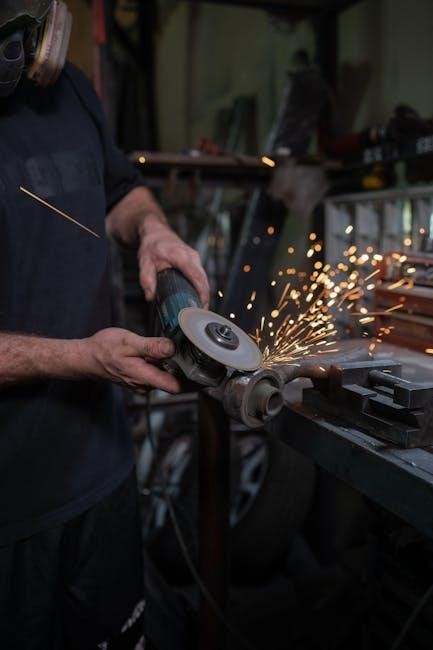Craftsman Garage Door Opener: A Comprehensive Guide
Craftsman garage door openers offer reliable access and security, requiring careful operation and maintenance for optimal performance; this guide provides detailed
instructions.
Understanding safety features, troubleshooting common issues, and performing regular upkeep will extend the lifespan of your Craftsman opener system.
From initial setup to advanced settings, this resource equips you with the knowledge to confidently manage your garage door opener effectively and safely.
Understanding Your Craftsman Garage Door Opener
Craftsman garage door openers represent a blend of convenience and security for your home, but maximizing their benefits requires a foundational understanding of how they function. These systems aren’t simply motors; they’re integrated mechanisms involving sensors, logic boards, and precise motor controls. Familiarizing yourself with these components is the first step towards effective operation and troubleshooting.
The core function revolves around safely lifting and lowering your garage door, utilizing a travel limit system to define the door’s open and closed positions. Safety sensors, crucial for preventing accidents, create an invisible beam; obstruction of this beam triggers an immediate reversal. Understanding the ‘learn’ button’s role in programming remotes and keypads is also vital.
Different Craftsman models possess unique features, so identifying your specific opener is paramount. Regular inspection of wiring and hardware ensures continued reliable performance, while recognizing potential issues early can prevent costly repairs.
Key Features and Benefits
Craftsman garage door openers boast a range of features designed for convenience, security, and peace of mind. Key benefits include enhanced home security through reliable door operation and remote access control. Modern models often integrate smart home compatibility, allowing operation via smartphone apps and voice commands. The safety sensors are a paramount feature, preventing the door from closing on obstructions, safeguarding children and pets.
Beyond safety, Craftsman openers offer varying horsepower options to accommodate different door sizes and weights. Features like battery backup ensure functionality during power outages. The ability to program multiple remotes and keypads provides flexible access for family members.
Furthermore, the durable construction and robust motors contribute to long-term reliability, minimizing maintenance needs. These features collectively elevate the homeowner experience, providing both practicality and security.
Model Variations: Identifying Your Opener
Craftsman garage door openers come in diverse models, each with unique specifications and features. Identifying your specific model is crucial for accessing the correct manuals, parts, and troubleshooting guides. Key identifiers include the model number, typically found on a sticker located on the opener unit itself, often on the motor housing or near the light fixture.
Common variations include chain drive, belt drive, and direct drive openers. Chain drive models are generally more affordable but noisier, while belt drive options offer quieter operation. Direct drive systems are known for their durability and minimal moving parts.
Horsepower ratings (1/2 HP, 3/4 HP, etc.) also differentiate models, influencing their ability to handle heavier doors. Understanding these distinctions ensures you select the right resources for your opener’s maintenance and repair.

Installation Process
Craftsman garage door opener installation demands precision and adherence to safety guidelines; proper mounting, connection, and adjustment are vital for reliable operation.
Preparing for Installation: Tools and Safety
Before beginning the Craftsman garage door opener installation, gather essential tools: a ladder, socket wrench set, screwdrivers (Phillips and flathead), wire strippers, electrical tape, a drill with various bits, safety glasses, and work gloves.
Crucially, disconnect the power supply to the garage circuit breaker to prevent electrical shock; verify it’s off with a non-contact voltage tester. Inspect the garage door’s balance – a properly balanced door should stay stationary midway when opened or closed manually.
Ensure the work area is clear of obstructions and well-lit. Read the Craftsman opener’s manual thoroughly, understanding all safety warnings and instructions. If you’re uncomfortable with electrical work or door mechanics, consult a qualified professional for assistance; safety is paramount throughout the entire process.
Mounting the Opener Unit
Begin by assembling the Craftsman opener rail sections, following the manual’s diagrams precisely. Position the assembled rail securely along the ceiling joists, ensuring adequate clearance for the door’s full travel. Utilize the provided mounting brackets, attaching them firmly to the joists with lag screws – pre-drilling pilot holes is recommended to prevent splitting the wood.
Carefully lift the opener unit onto the mounted rail, aligning it with the brackets. Secure the unit to the brackets using bolts and washers, tightening them firmly but avoiding over-tightening. Double-check the rail’s stability and alignment; a wobbly rail can cause operational issues and premature wear.
Confirm the opener unit is level and securely fastened before proceeding to the next installation step; a solid mounting foundation is critical for reliable performance.
Connecting the Door Arm and Hardware
Attach the door bracket to the garage door, centering it on the door panel and securing it with bolts. Connect the door arm to the door bracket, ensuring a snug fit and proper alignment with the opener’s trolley. This connection transmits the opener’s force to lift and lower the door.
Install the safety sensors near the floor on both sides of the door, aligning them to face each other. These sensors are crucial for preventing the door from closing on obstructions. Connect the sensor wires to the opener unit, following the wiring diagram carefully.
Verify all connections are secure and that the door arm moves freely without binding. Proper hardware installation is essential for safe and efficient operation of your Craftsman garage door opener.
Adjusting Travel Limits and Force Settings
Set the up and down travel limits using the adjustment screws on the opener unit; these control how far the door opens and closes. Begin with conservative settings and gradually increase until the door reaches the desired height and fully closes.
Adjust the force settings to determine the amount of power the opener uses to overcome door weight and resistance. Start with the lowest force setting and incrementally increase it until the door operates smoothly without reversing unexpectedly.
Fine-tune these settings for optimal performance and safety, ensuring the door reverses immediately upon encountering an obstruction. Proper adjustment prevents damage to the door and ensures reliable operation of your Craftsman opener.

Troubleshooting Common Issues
Diagnose and resolve frequent problems like safety sensor malfunctions, remote control failures, power supply issues, and door reversal difficulties with these helpful steps.
Addressing unusual noises promptly ensures continued safe and efficient operation of your Craftsman garage door opener system, preventing further damage.
Safety Sensor Alignment and Cleaning

Ensuring proper functionality of your Craftsman garage door opener’s safety sensors is paramount for preventing accidents and ensuring safe operation. These sensors, located near the floor on either side of the door, create an invisible beam.
If the beam is interrupted – by an object or person – the door will automatically reverse. Misalignment is a common cause of operational issues; carefully check that the sensor lenses are facing each other directly.
Adjust the brackets if necessary, ensuring they are securely tightened after adjustment. Regularly clean the sensor lenses with a soft cloth to remove dirt, dust, and debris that can obstruct the beam.
Even a thin layer of grime can interfere with the sensors’ ability to detect obstructions. Test the sensors after cleaning by placing an object in the door’s path while closing it; the door should reverse immediately.
If problems persist, consult the opener’s manual or seek professional assistance to avoid potential hazards.
Remote Control Problems: Batteries and Programming
When your Craftsman garage door opener remote stops working, the first step is always to check the batteries. Replace them with fresh ones, ensuring correct polarity. If the remote still fails to operate, the issue may lie with programming.
Most Craftsman openers require a “learn” button press on the opener unit itself to initiate the programming process. Locate this button – often yellow or orange – and press it briefly. Within 30 seconds, press the desired button on your remote.
The opener should respond with a light or audible confirmation. Repeat this process for additional remotes. If you’re still experiencing difficulties, try clearing all existing remote codes by holding the “learn” button for an extended period.
Then, reprogram all remotes from scratch. Ensure you are within range of the opener during programming. If issues persist, consult the owner’s manual or contact customer support.
Opener Not Responding: Power Supply Checks
If your Craftsman garage door opener isn’t responding, begin by verifying the power supply. First, ensure the opener is securely plugged into a functioning electrical outlet. Test the outlet with another device to confirm it’s providing power.
Next, check the circuit breaker in your electrical panel. A tripped breaker can cut power to the opener. Reset the breaker if necessary. Also, inspect the fuse within the garage door opener unit itself; a blown fuse will prevent operation.
Replace the fuse with one of the correct amperage rating. Examine the wiring for any loose connections or damage. If wiring appears compromised, consult a qualified electrician.
Confirm the wall control has power and isn’t the source of the issue. A lack of power is a common cause, so thorough checks are essential for restoring functionality.
Garage Door Reversal Issues: Sensitivity Adjustment
If your Craftsman garage door reverses unexpectedly, sensitivity adjustment is often the solution. Locate the adjustment dials on the opener unit – typically labeled “Force” and “Sensitivity.” Begin by slightly decreasing the sensitivity setting. This reduces the opener’s reaction to obstructions.
Gradually increase the “Force” setting, allowing the opener to apply more power to overcome minor resistance. Test the door’s operation after each adjustment. Ensure the door closes completely without reversing.
Remember, safety is paramount. Avoid increasing the force excessively, as this could compromise the safety sensors. If adjustments don’t resolve the issue, inspect the door’s balance and track for obstructions.
Proper sensitivity and force settings ensure safe and reliable operation, preventing accidental reversals and potential hazards.
Addressing Unusual Noises During Operation
Unusual noises from your Craftsman garage door opener signal potential maintenance needs. Grinding sounds often indicate worn gears within the opener unit, requiring professional repair or replacement. Squeaking noises typically stem from lack of lubrication on moving parts – rollers, hinges, and the door track.
Apply lithium-based lubricant to these areas, avoiding chain-driven openers which require specific chain lubricant. Rattling sounds may indicate loose hardware; inspect and tighten all bolts and screws. Clicking noises could signify issues with the limit switches.
If noises persist after lubrication and tightening, consult a qualified technician to diagnose and address more complex problems, ensuring safe and quiet operation.

Maintenance and Care

Regular upkeep extends your Craftsman opener’s life; lubricate moving parts, inspect hardware for tightness, and replace worn components promptly for optimal function.
Regular Lubrication of Moving Parts
Consistent lubrication is paramount for smooth, quiet operation of your Craftsman garage door opener, preventing premature wear and tear on critical components. Utilize a silicone-based lubricant, specifically designed for garage door systems, avoiding oil-based products which attract dust and grime.
Focus on the rollers, hinges, springs, and the opener’s chain or belt drive. Apply lubricant sparingly to each moving part, wiping away any excess to prevent buildup. The track should also receive attention, ensuring smooth movement of the door.
A well-lubricated system reduces strain on the motor, extending its lifespan and minimizing the need for frequent repairs. Aim to lubricate these parts at least twice a year, or more often in harsh climates, contributing to a reliable and efficient garage door operation.
Inspecting and Tightening Hardware
Regular inspection of your Craftsman garage door opener’s hardware is crucial for safety and functionality. Begin by visually examining all bolts, nuts, and screws on the door, tracks, and opener unit itself; Pay close attention to areas experiencing high stress or movement, like hinge plates and bracket connections.
Use a wrench or screwdriver to gently tighten any loose hardware, but avoid over-tightening, which can strip threads or damage components. Check the door’s alignment, ensuring it moves smoothly within the tracks without binding. Inspect the springs for signs of wear, rust, or damage, and consult a professional if issues are detected.
Consistent hardware checks prevent minor issues from escalating into costly repairs, maintaining the integrity and safe operation of your garage door system.
Checking and Replacing Worn Components
Proactive maintenance involves regularly checking for worn components in your Craftsman garage door opener system. Inspect the drive belt or chain for cracks, fraying, or excessive wear, replacing it if necessary to prevent breakage and ensure smooth operation. Examine the rollers for damage, replacing any that are cracked, chipped, or not rolling freely.
Check the door’s cables for fraying or corrosion, and never attempt to repair them yourself – always consult a professional. Inspect the limit switches and safety sensors for damage or misalignment, replacing them if they are malfunctioning. Replacing worn parts promptly prevents further damage and maintains the safety and reliability of your opener.
Remember to disconnect power before any component replacement for safety.

Advanced Features and Settings
Craftsman openers boast customizable settings, including multiple remote programming, keypad functionality, and smart home integration for enhanced convenience and control.
Explore these options to personalize your garage door experience and optimize security features for your specific needs and preferences.
Programming Multiple Remotes
Craftsman garage door openers allow for programming several remote controls, enhancing convenience for multiple users. Begin by locating the “Learn” button on your opener unit – its color varies by model, often purple, orange, or yellow. Press and release this button; a small LED indicator light will illuminate, signaling the opener is in programming mode.
Within 30 seconds, press and hold the button on the remote you wish to program until the garage door opener light flashes, confirming successful programming; Repeat this process for each additional remote control. If programming fails, ensure the remote has fresh batteries and is within range of the opener. Some models may require clearing existing remotes before adding new ones; consult your specific model’s manual for detailed instructions. Remember to test each remote after programming to verify functionality.
Utilizing the Keypad Functionality
Craftsman garage door openers often include an external keypad for keyless entry, offering a convenient alternative to remote controls. To program a personal access code, locate the “Learn” button on the opener unit and press it, initiating programming mode as indicated by the illuminated LED. Enter a four-digit code on the keypad, followed by pressing the “Enter” or “#” key.
The opener light should flash, confirming code acceptance. Test the code to ensure proper operation. For security, choose a code not easily guessed, and change it periodically. Some keypads allow multiple codes for different users. Refer to your model’s manual for specific instructions regarding code length limitations and advanced features like temporary access codes. Regularly check and replace the keypad batteries to maintain functionality.
Smart Home Integration Options
Craftsman garage door openers are increasingly compatible with smart home systems, enhancing convenience and security. Many models can integrate with platforms like Google Assistant and Amazon Alexa, allowing voice control for opening and closing the door. To enable this, typically you’ll need a compatible smart hub, such as Chamberlain’s MyQ, which connects the opener to your home’s Wi-Fi network.
Through the MyQ app, you can monitor door status, receive alerts, and control the opener remotely. Installation involves linking your Craftsman opener to the hub following the app’s guided setup process. Ensure your Wi-Fi signal is strong near the opener. Check compatibility with your specific opener model before purchasing a smart hub.

Safety Precautions
Craftsman garage door openers demand strict adherence to safety guidelines; always test safety sensors and understand the emergency release mechanism for secure operation.
Regularly inspect the system and prevent accidents by keeping children away during operation, ensuring a safe environment for everyone involved.
Understanding Safety Sensor Functionality
Craftsman garage door openers are equipped with crucial safety sensors, typically located near the floor on either side of the door opening, designed to prevent the door from closing on obstructions.
These sensors emit an invisible infrared beam; if this beam is interrupted by an object – a person, pet, or vehicle – the opener will reverse the door’s direction, preventing potential damage or injury.
Proper alignment is paramount; misaligned sensors are a frequent cause of operational issues, triggering false reversals or preventing the door from closing altogether. Regularly inspect the lenses for dirt, dust, or debris, as obstructions can interfere with the beam.
Cleaning the lenses with a soft cloth is essential for maintaining functionality. If the sensors continue to malfunction, verify the wiring connections and ensure the sensors are securely mounted. Bypassing the sensors for testing is strongly discouraged, as it compromises safety.
Understanding and maintaining these sensors is vital for safe and reliable operation of your Craftsman garage door opener.

Emergency Release Procedures
Craftsman garage door openers feature an emergency release mechanism, allowing manual operation of the door during power outages or opener malfunctions. This cord typically hangs from the central rail of the opener unit.
To disengage the opener, gently pull the cord downwards; this will disconnect the carriage from the door, enabling you to lift or lower the door manually. Exercise caution, as the door may be heavy and require significant force.
Before attempting to operate the door manually, ensure the area is clear of obstructions and that no one is in the path of the moving door. After restoring power or repairing the opener, remember to re-engage the emergency release by pulling the cord upwards until it clicks into place.
Failure to re-engage the opener will prevent it from functioning correctly. Familiarize yourself with this procedure to ensure safe access to your garage in emergency situations. Always prioritize safety when using the manual release.
Regularly test the emergency release to confirm it operates smoothly and efficiently.
Preventative Measures to Avoid Accidents
Prioritizing safety is crucial when operating a Craftsman garage door opener. Regularly inspect the safety sensors, ensuring they are aligned and free from obstructions; these sensors prevent the door from closing on people or objects.
Keep the garage door area clear of toys, tools, and other items that could interfere with the door’s movement. Never allow children to play near the garage door or operate the opener without adult supervision.
Conduct monthly tests of the safety reversal system by placing a one-inch object in the door’s path while closing. The door should immediately reverse direction upon contact.
Avoid walking or driving under a closing garage door. Familiarize all household members with the emergency release procedure and proper operation of the opener. Routine maintenance, including lubrication and hardware checks, contributes to safe operation.
Always heed warning labels and follow manufacturer’s instructions.

Craftsman Opener Specifics
Craftsman openers utilize unique wiring diagrams and logic boards; understanding these components is vital for effective repairs and troubleshooting, ensuring optimal functionality.
Wiring Diagrams for Common Models
Craftsman garage door openers, while generally consistent in function, exhibit variations in wiring configurations across different models and manufacturing years. Accessing accurate wiring diagrams is crucial for safe and effective troubleshooting, repairs, or installations. Online resources, including the Craftsman website and dedicated DIY forums, often provide schematics for popular models like the 1/2 HP 315 and similar units.
These diagrams illustrate the connections between the logic board, safety sensors, wall control, remote receiver, and the motor itself. Always disconnect power before working with wiring. Common issues often stem from loose connections or damaged wires, particularly within the safety sensor circuits. Diagrams help identify the correct wire colors and terminal locations for proper reconnection. When replacing the logic board, a diagram is essential to ensure all components are correctly wired to the new unit, preventing malfunctions and ensuring safe operation. Remember to consult the specific diagram for your model number.
Identifying and Replacing the Logic Board
The logic board, often called the control board, is the “brain” of your Craftsman garage door opener. Identifying a faulty logic board often involves observing consistent malfunctions – the opener not responding, erratic behavior, or issues with safety features. Before replacement, verify power supply and wiring connections. Locate your opener’s model number (usually on a sticker) to order the correct replacement board.
Disconnect power before beginning. Carefully document the existing wiring connections – photos are highly recommended! Remove the old board and install the new one, meticulously reconnecting each wire to its corresponding terminal, referencing your documentation or wiring diagrams. After installation, proceed with reprogramming remotes and testing all functions, including safety reversal and sensor alignment. A properly replaced logic board restores reliable operation.
Understanding Learn Button Functions
The “learn” button on your Craftsman garage door opener is crucial for synchronizing remotes, keypads, and other accessories. Its function allows the opener to recognize new devices. Typically, pressing and releasing the learn button activates a two-minute window for programming. During this time, activate the desired remote or enter the code on the keypad. The opener will signal successful programming with a click or indicator light.
Different Craftsman models may have varying learn button locations and procedures. Some require holding the button until the light flashes. Refer to your owner’s manual for specific instructions. If programming fails, ensure fresh batteries in the remote and repeat the process. Understanding these functions simplifies adding or replacing accessories, ensuring seamless operation.